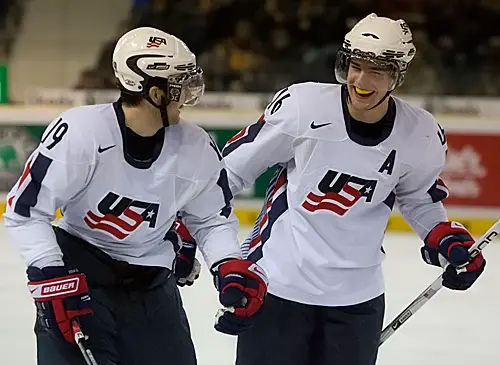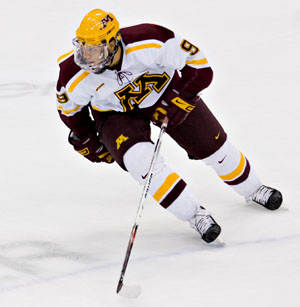First and foremost, happy new year! Now let’s hope we never hear any of this crap ever again.
Gag.
Speaking of Gags…
It has always been asserted, with all justification, that the best way to improve the league’s standing on the national stage is to win the big games.
And by “big games,†we mean nonconference games. Tournaments. And, of course, NCAA tournament games. There is little point in beating RPI points out of league opponents; they tend to even out over the course of the season by such mechanisms as the “common opponents†factor. The real boosts come through stealing points from other leagues.
So how is ECAC Hockey stacking up so far?
Not so good.
Eight teams participated in NCAA-sanctioned winter tournaments last month (not including Union’s games against Canadian opponents in the Pete Kelly Tournament), but only three made it to their tourney’s respective championships.
Ignoring the Cornell-Clarkson consolation game in the Florida College Classic, the league finished 4-9-1 in the midseason tourneys, with only one champion — Quinnipiac, defeating host Vermont in the Catamount Cup.
Despite holding a winning record against the other leagues until mid-December, the ECAC has since seen its overall score drop to 30-37-8 against non-conference foes…including a 13-31-0 record against the WCHA, CCHA and Hockey East.
With the meat of the league schedule coming up, only Colgate, Quinnipiac, Dartmouth and Yale have winning non-con records. These teams will likely see an extra shot to their PairWise Rankings by the end of the season, while perhaps a program of equal standing in the league fixtures might be left behind.
It’s Our Differences That Make Us Special
The ECAC has some unique conditions that set it apart from other major sports conferences, and these affect all aspects of athletic competition. But don’t make the mistake of calling these situations “limitations because by many standards, they’re anything but.
Plain and simple, the Ivies mark the greatest deviation from the NCAA norm. They cap their regular seasons at 29 games, they start later in the fall, they don’t offer athletic scholarships (nor does Union, for that matter), and their standards for admission are understandably higher than many other schools’.
However, how much does this really hamper the Ivy League programs, and how much does it handicap the rest of the league in turn?
“I don’t think [the lack of scholarship players] has hindered them at all,†said league commissioner Steve Hagwell of the Ivy teams. He pointed to past St. Lawrence teams and the current RIT program for examples of success-sans-scholarships (before the Saints began offering them, of course).
That said, sure, maybe some of the top recruits won’t qualify as Ivy or ECAC material scholastically. But while the perspective has been murky of late, it is important to remember that these are students first, and athletes second.
“What the ECAC — as a league, and not just hockey — is better at than probably any other league is combining the student with the athlete,†said Rensselaer head coach Seth Appert. With such strong academic reputations among these institutions, it is truly the well-rounded individual who can lace up in this league.
Appert also belittled the idea that fewer games in a season automatically handicapped a team.
“Sometimes the Ivies can start later and fresher,†he said, catching opponents before the bumps and bruises begin to set in for the winter.
Likewise, their 29-game cap allows for seven non-conference matchups. While teams like Quinnipiac, Clarkson or Colgate might play a dozen such contests in a season, the cap isn’t as large a detriment as it may seem.
“The CCHA and Hockey East play 28- and 27-game league schedules, which leaves them with six [or seven] non-league slots,†said Hagwell — the same allowed for Harvard, Dartmouth or Princeton.
To be sure, Cornell and Harvard haven’t exactly been falling behind the pack in the last few years, despite their Ivy status.
Overall though, the success of the league and each of the programs comprising it is in the hands of the institutions and the coaches.
“We’ve gotta win nonconference games,†said Hagwell…and everyone agrees with that.
Deep and Dangerous
The Bobcats reeled off five wins in a row to straddle the break, and won on the strength of solid team defense and surprising depth.
“As well as we played in those five games, [what is more notable] is how many players we’ve had out,†said coach Rand Pecknold.
“We beat Vermont with four players out,†he said, including captain Jaime Bates and assistant captain Matt Sorteberg.
“The team defense really goes back to the injuries,†said Pecknold. “Guys have been rising to the occasion†to make the most of their minutes, he said.
Senior Dan Travis potted a pair against UVM, and Brandon Wong showed a consistently higher level of play than he did earlier this year.
“I think my veteran guys have definitely turned the corner,†the coach said. “Our special teams have been really good,†he added.
Citing a grittiness to his charges, the veteran coach is pleased with the extra efforts he is seeing from his maturing team.
Over the quintet of Ws, Quinnipiac surrendered only seven goals and got outstanding goaltending from a reinvigorated Bud Fisher and from senior Peter Vetri, who is no longer with the program. In his final year of collegiate eligibility following a transfer from UMass-Lowell, Vetri was dismissed from the team for failure to fulfill academic obligations. Freshman Pat McGann steps in as the second-stringer.
For this weekend’s games against Harvard and Dartmouth, the ‘Cats are again likely to be without the services of Sorteberg, Bates, Mark Nelson and Jake Bauer. Even third-string goaltender Dan Cullen is out of action this weekend, according to Pecknold.
“It’s like a walking M.A.S.H. unit,†he joked.
The Mighty Not Falling
Well, not for Rensselaer, they’re not.
The Engineers were put to the test with four straight games against top-flight opposition: two games hosting top-ranked Miami, a game against fourth-ranked Colorado College and another tilt against sixth-ranked Notre Dame.
Unfortunately for Appert and the ‘Tute, it was four times up and four times down.
“I’m disappointed we didn’t have more success of course,†the coach said. “But I was really pleased with our game against Notre Dame.â€
Playing the late game against CC in the first round of the Lightning Classic in Tampa, RPI took off to a 2-0 lead with a pair of second-period goals. However, the Tigers stormed back with three in the third, including the game-winning power-play goal with only seven ticks left ’til the buzzer.
Appert said that it would’ve been easy to play a tired, dispirited game against the Irish, who had just stung RPI at the end of November. Instead, the Engineers hung tough, and a 2-1 first-period deficit stuck fast for the final 40 minutes of play, other than an empty-netter with 29 seconds left.
Going further back, the deuce against Miami was enjoyable for Appert in principle, if not outcome.
“Miami is the premier team we’ve played this year,†said the coach. “They’re the nastiest team we’ve played…a great combination of skill, physicality and a little bit of nastiness.â€
Appert said he missed the two-game sets against one opponent that he used to get out in the WCHA.
“I like the animosity you can get in those Saturday games,†after already playing a team the previous night. “I think in our league it might be easier to sweep [a weekend],†he continued. “It’s more difficult to beat a team two nights in a row.â€

